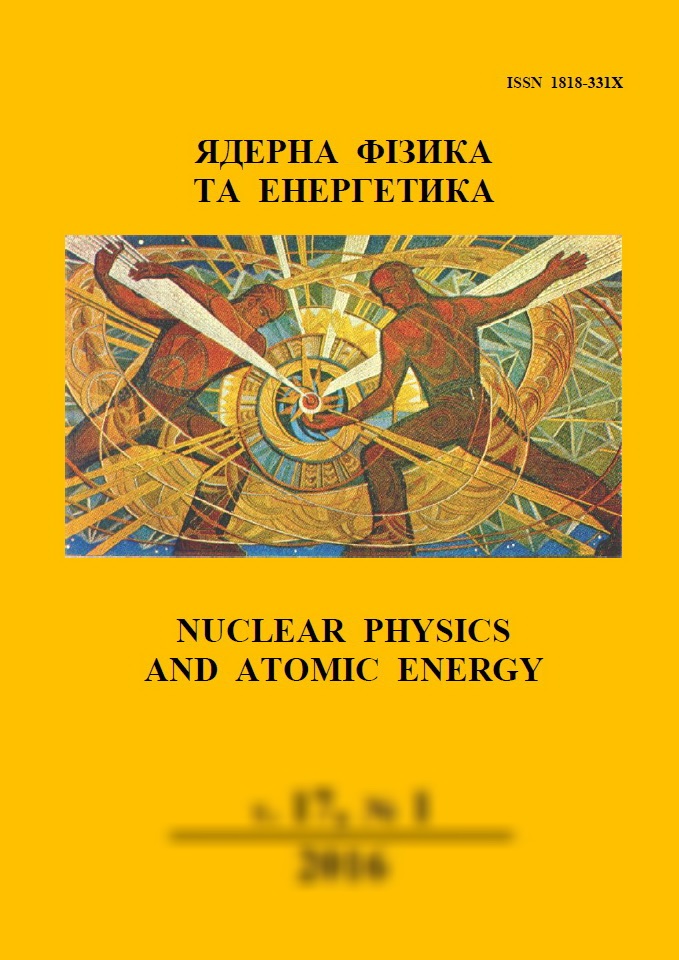 |
Ядерна фізика та енергетика
Nuclear Physics and Atomic Energy
ISSN:
1818-331X (Print), 2074-0565 (Online)
Publisher:
Institute for Nuclear Research of the National Academy of Sciences of Ukraine
Languages:
Ukrainian, English, Russian
Periodicity:
4 times per year
Open access peer reviewed journal
|
Nucl. Phys. At. Energy 2019, volume 20, issue 3, pages 265-270.
Section: Radiobiology and Radioecology.
Received: 02.04.2019; Accepted: 10.10.2019; Published online: 30.11.2019.
 Full text (ua)
Full text (ua)
https://doi.org/10.15407/jnpae2019.03.265
The low doses of X-rays radiation impact on the photoperiodic pathway genes in plants
M. V. Kryvokhyzha*, N. M. Rashydov
Institute of Cell Biology and Genetic Engineering of the National Academy of Sciences of Ukraine, Kyiv, Ukraine
*Corresponding author. E-mail address:
krivohizha.marina@gmail.com
Abstract:
The effects of small doses of irradiation on the activity of genes of the photoperiodic pathway were studied. The irradiation of 4 week old plants by X-ray radiation at doses of 3, 6, 9 and 15 Gy with a dose rate of 89 cGy/s and photon energy 6 MeV was carried out. The key genes of the photoperiodic path AP1, GI, FT, CO were selected for the study. The gene expression analysis in real time polymerase chain reaction (PCR) was performed. The statistical analysis of the quantitative PCR results was performed using the REST 2009 software. The relative expression was calculated by comparing the time when the experimental and control samples fluorescence curves cross the threshold. The studies indicated that plants irradiated with X rays in a dose up to 15 Gy started the flowering phase earlier then the control group. In addition, the expression of the key flowering genes increased in experimental plants. During the experiments, a nonlinear dependence of the change in the genes expression of the photoperiodic path in plants irradiated with low doses of radiation was found. The reaction from the mechanism of the flowering determination to low doses of radiation is not specific compared with the response to other abiotic stress factors.
Keywords:
flowering, small doses, X-ray radiation, photoperiodic path, gene expression, polymerase chain reaction, real-time polymerase chain reaction.
References:
1. O. Kravets et al. Dynamics of the yield of cytogenetic anomalies in the meristem of sprouts in chronic seed irradiation. Radiation Biology. Radioecology 3 (2008) 208.
2. D.M. Grodzinski et al. Induced by acute and chronic gamma irradiation damages to the generative system in Arabodopsis thaliana (p. Columbia). In: III Congress of Radiation Research (Radiobiology and Radioecology), Kyiv, May 21 - 25, 2003 (Kyiv, 2003) p. 180. (Ukr)
3. I. Kovalchuk et al. Transcriptome analysis reveals fundamental differences in plant response to acute and chronic exposure to ionizing radiation. Mutation Research 624(1) (2007) 101.
https://doi.org/10.1016/j.mrfmmm.2007.04.009
4. O.P. Dmitriev et al. Epigenetic Factors of Plant Adaptation (Kyiv: Palyvoda A.V., 2018) 284 p. (Ukr)
5. N. Rashydov et al. Radiobiological Characterization Environment around Object "Shelter". In: Nuclear Power Plant. Ed. by Soon Heung Chang. (Croatia, Rijeka, 2012) p. 231. Google Books
6. D.M. Grodzinski et al. Radiobiological Effects of Chronic Irradiation in the Area of Chornobyl Accident (Kyiv: Naukova Dumka, 2008) p. 373. (Ukr)
http://www.nas.gov.ua/UA/Book/Pages/default.aspx?BookID=0000012598
7. I.N. Gudkov, D.M. Grodzinski. Radiobiological effects of plants in the area of radiation influence of the accident at the Chernobyl Nuclear Power Plant today. In: Materials Intern. Conf. “Radiobiological Effects: Risks, Minimization, Forecast”, Kyiv, March 22 - 24, 2005 (Kyiv: National Scientific Center of Radiation Medicine of the National Medical Academy of Ukraine, 2005) p. 122. (Rus)
8. M.V. Kryvokhyzha, N.M. Rashydov. Alteration of flowering gene expression in response to UV-C irradiation of Arabidopsis thaliana plants grown under different light and temperature conditions. Biological systems 10(1) (2018) 8. (Ukr)
https://doi.org/10.31861/biosystems2018.01.008
9. L. Parenikova. Molecular and phylogenetic analyses of the complete MADS-box transcription factor family in Arabidopsis: New openings to the MADS world. The Plant Cell Online 15(7) (2003) 1538.
https://doi.org/10.1105/tpc.011544
10. The Arabidopsis genome initiative. Analysis of the genome sequence of the flowering plant Arabidopsis thaliana. Nature 408(6814) (2000) 796.
https://doi.org/10.1038/35048692
11. N.S. Mattson, J.E. Erwin. The impact of photoperiod and irradiance on flowering of several herbaceous ornamentals. Scientia Horticulturae 104(3) (2005) p. 275.
https://doi.org/10.1016/j.scienta.2004.08.018
12. S.G. Hwang et al. Transcriptome analysis of reproductive-stage Arabidopsis plants exposed gamma-ray irradiation at various doses. Int. J. Radiat. Biol. 92(8) (2016) 451.
https://doi.org/10.1080/09553002.2016.1178865
13. D.C. Boyes. Growth Stage-Based Phenotypic Analysis of Arabidopsis: A Model for High Throughput Functional Genomics in Plants. The Plant Cell Online 13(7) (2001) 1499.
https://doi.org/10.2307/3871382
14. M.V. Kryvokhyzha, K.V. Krutovsky, N.M. Rashydov. Differential expression of flowering genes in Arabidopsis thaliana under chronic and acute ionizing radiation. Int. J. Radiat. Biol. 95(5) (2019) 626.
https://doi.org/10.1080/09553002.2019.1562251
15. M.W. Pfaffl, G.W. Horgan, L. Dempfle. Relative Expression Software Tool (REST) for Group-Wise Comparison and Statistical Analysis of Relative Expression Results in Real-Time PCR. Nucleic Acids Research 30(9) (2002) e36.
https://doi.org/10.1093/nar/30.9.e36
16. REST 2009 Software User Guide, QIAGEN GmbH (2009) 28 p.
https://www.gene-quantification.de/REST_2009_Software_User_Guide.pdf
17. S.V. Litvinov, N.M. Rashydov. Relative radio-sensitivity of Arabidopsis thaliana ATMSH2 SALK_002708 mutant in the sublethal dose range of radiation. Yaderna Fizyka ta Energetyka (Nucl. Phys. At. Energy) 19(2) (2018) 145. (Ukr)
https://doi.org/10.15407/jnpae2018.02.145
18. N.M. Rashydov, O.G. Nesterenko. The problems sustainable remediation of the Chernobyl alienation areas. Journal of Radiation Researches 5(2) (2018) 13.
http://irp.science.az/uploads/pdf/2)_irp_journal_-_2018-2_11-25.pdf
